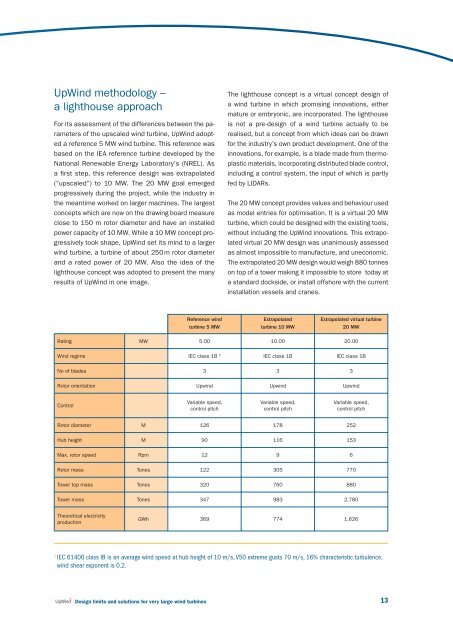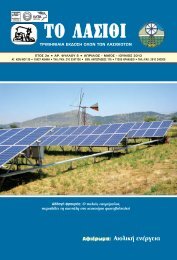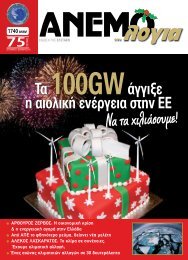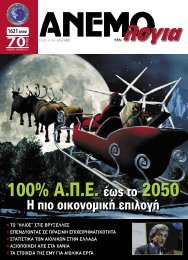Design limits and solutions for very large wind turbines
Design limits and solutions for very large wind turbines
Design limits and solutions for very large wind turbines
You also want an ePaper? Increase the reach of your titles
YUMPU automatically turns print PDFs into web optimized ePapers that Google loves.
UpWind methodology –<br />
a lighthouse approach<br />
For its assessment of the differences between the parameters<br />
of the upscaled <strong>wind</strong> turbine, UpWind adopted<br />
a reference 5 MW <strong>wind</strong> turbine. This reference was<br />
based on the IEA reference turbine developed by the<br />
National Renewable Energy Laboratory's (NREL). As<br />
a first step, this reference design was extrapolated<br />
(“upscaled”) to 10 MW. The 20 MW goal emerged<br />
progressively during the project, while the industry in<br />
the meantime worked on <strong>large</strong>r machines. The <strong>large</strong>st<br />
concepts which are now on the drawing board measure<br />
close to 150 m rotor diameter <strong>and</strong> have an installed<br />
power capacity of 10 MW. While a 10 MW concept progressively<br />
took shape, UpWind set its mind to a <strong>large</strong>r<br />
<strong>wind</strong> turbine, a turbine of about 250 m rotor diameter<br />
<strong>and</strong> a rated power of 20 MW. Also the idea of the<br />
lighthouse concept was adopted to present the many<br />
results of UpWind in one image.<br />
The lighthouse concept is a virtual concept design of<br />
a <strong>wind</strong> turbine in which promising innovations, either<br />
mature or embryonic, are incorporated. The lighthouse<br />
is not a pre-design of a <strong>wind</strong> turbine actually to be<br />
realised, but a concept from which ideas can be drawn<br />
<strong>for</strong> the industry’s own product development. One of the<br />
innovations, <strong>for</strong> example, is a blade made from thermoplastic<br />
materials, incorporating distributed blade control,<br />
including a control system, the input of which is partly<br />
fed by LIDARs.<br />
The 20 MW concept provides values <strong>and</strong> behaviour used<br />
as model entries <strong>for</strong> optimisation. It is a virtual 20 MW<br />
turbine, which could be designed with the existing tools,<br />
without including the UpWind innovations. This extrapolated<br />
virtual 20 MW design was unanimously assessed<br />
as almost impossible to manufacture, <strong>and</strong> uneconomic.<br />
The extrapolated 20 MW design would weigh 880 tonnes<br />
on top of a tower making it impossible to store today at<br />
a st<strong>and</strong>ard dockside, or install offshore with the current<br />
installation vessels <strong>and</strong> cranes.<br />
Reference <strong>wind</strong><br />
turbine 5 MW<br />
Extrapolated<br />
turbine 10 MW<br />
Extrapolated virtual turbine<br />
20 MW<br />
Rating MW 5.00 10.00 20.00<br />
Wind regime IEC class 1B 2 IEC class 1B IEC class 1B<br />
No of blades 3 3 3<br />
Rotor orientation Up<strong>wind</strong> Up<strong>wind</strong> Up<strong>wind</strong><br />
Control<br />
Variable speed,<br />
control pitch<br />
Variable speed,<br />
control pitch<br />
Variable speed,<br />
control pitch<br />
Rotor diameter M 126 178 252<br />
Hub height M 90 116 153<br />
Max. rotor speed Rpm 12 9 6<br />
Rotor mass Tones 122 305 770<br />
Tower top mass Tones 320 760 880<br />
Tower mass Tones 347 983 2,780<br />
Theoretical electricity<br />
production<br />
GWh 369 774 1,626<br />
2<br />
IEC 61400 class IB is an average <strong>wind</strong> speed at hub height of 10 m/s, V50 extreme gusts 70 m/s, 16% characteristic turbulence,<br />
<strong>wind</strong> shear exponent is 0.2.<br />
<strong>Design</strong> <strong>limits</strong> <strong>and</strong> <strong>solutions</strong> <strong>for</strong> <strong>very</strong> <strong>large</strong> <strong>wind</strong> <strong>turbines</strong><br />
13









